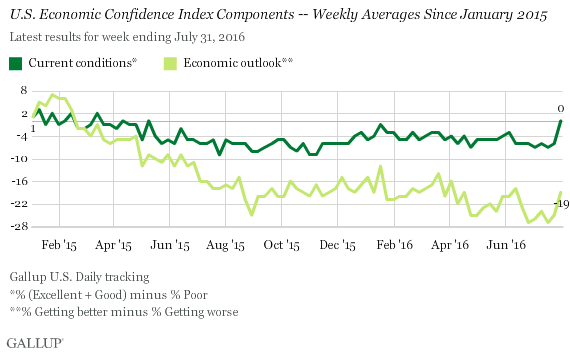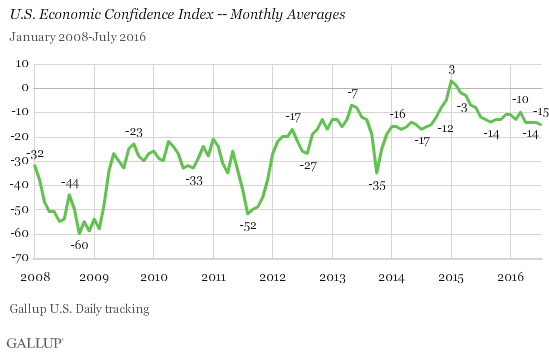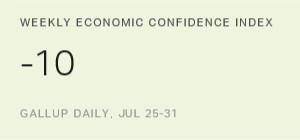Story Highlights
- As Democrats tout economy, their confidence in it spikes
- July average comes in at -15, essentially no change from June
- Confidence in economy climbs 12 points among Democrats
WASHINGTON, D.C. -- The Gallup Economic Confidence Index rose sharply for the week of July 25-31, climbing to -10. This broke a six-week streak in which the index did not reach any higher than -15 -- the average for July.

The economy featured prominently in the speeches of many Democratic leaders at the Democratic National Convention last week in Philadelphia, including President Barack Obama and Vice President Joe Biden. In his prime-time address to the convention, Obama declared "after the worst recession in 80 years," the country had "fought (its) way back." Other speakers, including the nominee Hillary Clinton, pointed to an unemployment rate at an almost eight-year low and a recovery that has generated 15 million jobs as evidence of the economy's strength.
At least some in the U.S. appear to have found these arguments compelling with economic confidence increasing to -10 from -16 the week before. This is despite the disappointing Friday announcement by the U.S. Commerce Department that U.S. GDP growth came in at 1.2% for the second quarter of 2016. Additionally, the Gallup U.S. Economic Confidence Index three-day rolling average moved as high as -8 over July 27-29, its highest score since mid-March.
Economic confidence increased sharply among Democrats and Democratic-leaning independents last week, up 12 points from +16 to +28. Economic confidence among Republicans and Republican-leaners did not change, holding at a -44 index score.

The disparity in economic confidence between Republicans and Democrats widened to its highest point yet in 2016, with the gap between these parties' economic confidence measuring 72 points.
Gallup's U.S. Economic Confidence Index is the average of two components: how Americans rate current economic conditions and whether they feel the economy is improving or getting worse. The index has a theoretical maximum of +100 if all Americans say the economy is doing well and improving, and a theoretical minimum of -100 if all Americans say the economy is doing poorly and getting worse.
Both components of the U.S. Economic Confidence Index saw notable improvement for the week of July 25-31. Equal percentages of Americans (28%) described current economic conditions as "excellent" or "good" as said they were "poor," bringing the current conditions index to the neutral point of 0. This is up six points from the week before.
Meanwhile, nearly four in 10 U.S. adults (38%) said economic conditions in the country were "getting better," compared with 57% who said they were getting worse, for a future conditions index score of -19. This is also up six points from the third week of July.

Confidence in July Finishes Lower Than Any Month in 2016
These late-month improvements in economic confidence, however, did little to prop up the average score for the entire month of July, which finished at -15, the lowest for any month in the past year. This is essentially on par with the -14 average recorded in April, May and June.

Bottom Line
Though the Gallup U.S. Economic Confidence Index had a mostly lackluster July, the measure saw dramatic improvement last week, fueled by Democrats' increasing optimism about the economy. Whether Democrats and other Americans will hold on to this rosier economic view remains to be seen. Friday's second-quarter GDP estimate, firmly below the consensus estimate of 2.5%, serves as a reminder that the economic recovery, though long by historical standards, remains tepid. But if confidence remains at these new levels, it could be a positive sign for the Clinton campaign. After the last Democratic convention in September 2012, Gallup saw an even larger improvement in economic confidence, an 11-point increase from -29 to -18. That movement proved to have staying power, with confidence roughly holding at that level through the 2012 election that saw the Democrats retain the White House.
These data are available in Gallup Analytics.
Survey Methods
Results for this Gallup poll are based on telephone interviews conducted July 25-31, 2016, on the Gallup U.S. Daily survey, with a random sample of 3,541 adults, aged 18 and older, living in all 50 U.S. states and the District of Columbia. For results based on the total sample of national adults, the margin of sampling error is ±2 percentage points at the 95% confidence level. All reported margins of sampling error include computed design effects for weighting.
Each sample of national adults includes a minimum quota of 60% cellphone respondents and 40% landline respondents, with additional minimum quotas by time zone within region. Landline and cellular telephone numbers are selected using random-digit-dial methods.
Learn more about how the Gallup U.S. Daily works.



